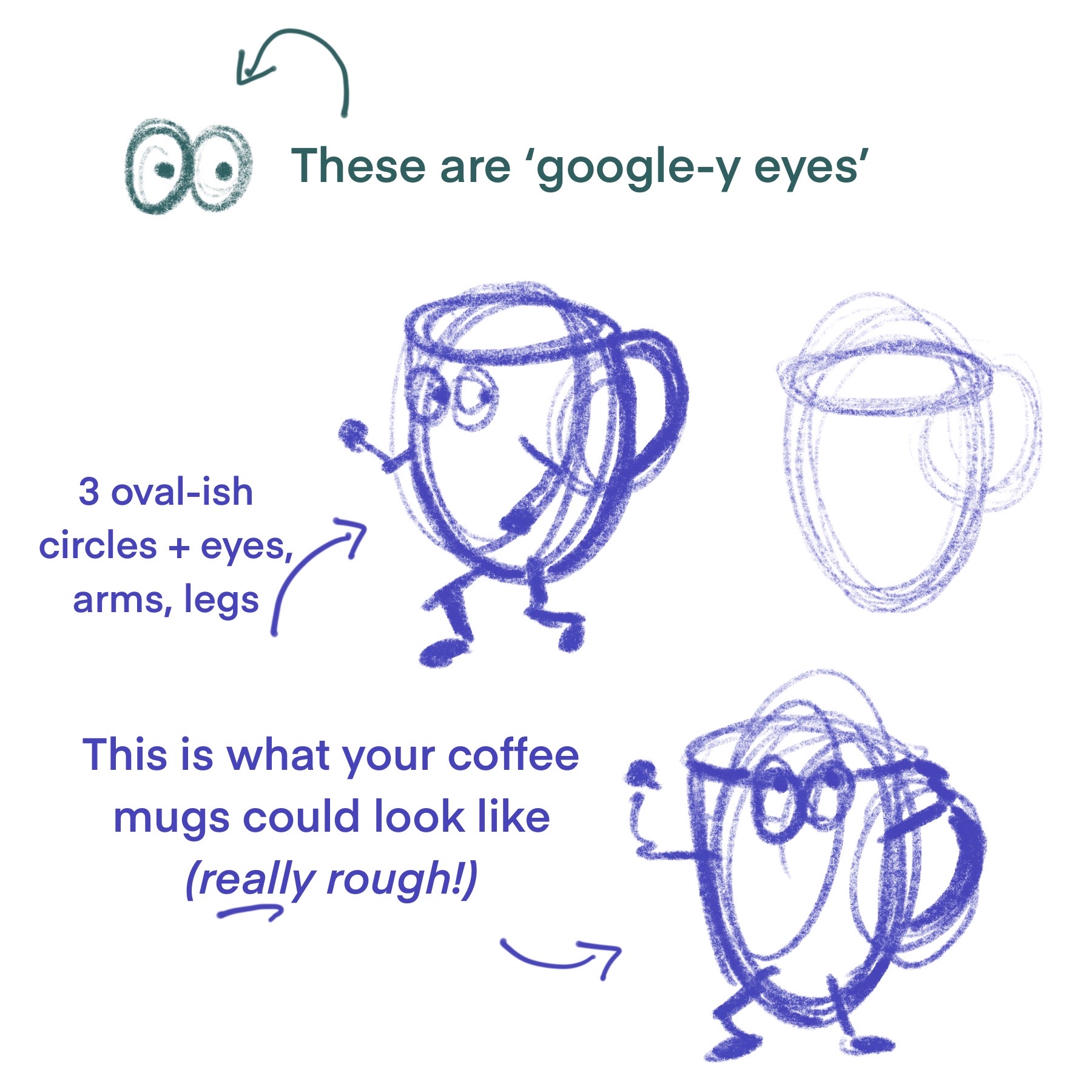
What cartooning basics do Tweety Bird and Pink Panther — along with numerous classic cartoon characters — have in common?
Once you figure it out you’ve distilled at least two things that you can use over and over to create a sense of cartooniness in anything you draw.
In essence, Tweety and Monsieur Le Pink are unexpected
Surprise is part and parcel of cartooning basics, so as soon as something is unexpected, it feels cartoony to us. Two ways in which Tweety and Pink are are unexpected (and which are the easy to use as a beginner) are:
- they behave more like humans and
- they have exaggeratedly large and expressive eyes
Shall we take a closer look at those points for a moment?
Tweety and Pink behave like humans
As you know by now anything is possible in Cartoonland, which is exactly why cartoonists get away with making animals behave like humans.
Watchers don’t bat an eyelid at Pink Panther walking about on two legs or Tweety gesturing with feathery ‘fingers’ — in fact, we delight in it. Somehow, seeing animals walk and talk like humans while still retaining some of the animal characteristics makes us cackle with laughter like a bunch of hens in a farm yard.
But what’s so special about the eyes?
Cartoon characters & ‘google-y eyes – cartooning basics there
This works like gangbusters because eyes do much of the work of portraying emotions, so having huge eyes makes sense when creating expressive cartoon characters. Making the eyes exaggeratedly large immediately conveys a sense of cartooniness to anyone watching.
So how can you test out these cartooning basics and stir up your imagination a little?
Here’s a wee exercise to get you going…
- Use circle-y circles (rough, sketchy oval shapes) to draw a rough-and-ready version of a coffee mug
- Add round, google-y eyes to it somewhere
- Draw sketchy legs and arms to make it seem ‘human’ and able to move
- When you are done, draw it again 2 or 3 times, varying the direction that the eye pupils are looking. You’ll notice that eye direction can change the whole mood of the ‘character’.
- And then draw it a few more times, varying how the legs and arms move

Don’t worry how good or bad it looks…
Just focus on the playful, ridiculous possibilities offered by having a dancing, google-eyed coffee mug scuttling about on your page.
Remember…
…the essence of cartooning basics is that anything is possible in Cartoonland
😉
Want More? Check these out…
Cartoon Outlining Skills — new tools or old?
Cartoon outlining skills — we all need them, daily! And Procreate is always bringing out new pens, pencils, brushes and other tools... Or are they? To be honest on any given day, I couldn't tell you. That's because I'm a creature of habit (so I stick to my favourites...
Tracing for Cartooning: Channeling Van Gogh to Learn Faster
Did you know that Vincent Van Gogh traced? Yep, he developed one of his super-famous works — The Courtesan — after being intrigued by the image of a Japanese woman in a fashion magazine (above right) and tracing it to get the essentials firmly in his mind. So if...
Cartoon ideas: inspiration from inside my garage
Cartoon ideas are literally everywhere...... and here I have the receipts to prove it 🤓. Do you see the shadowy shape of "Speedy" emerging from the photograph up above? That odd pattern of rough paint-on-brick-wall prickles my imagination to murmur the word...
How to Cartoonify Someone
How to cartoonify - this is a question that I get asked regularly, and this excellent photo someone was working with lends itself perfectly to a cartoonifying exercise for a beginner. So, where do you begin to learn how to cartoonify someone or something? If you have...
Different Cartooning Styles: Why Cartooning is As Unique As Handwriting
Different cartooning styles... and developing your own. Hmm, I get so many questions about this, so here's a quick insight via a recent Q & A... Q: "Sometimes I hear about different cartooning styles. I know of manga, but there must be more different styles. For...
Why You Should Copy Other Cartoonists (Even When you Have Your Own Ideas Already)
When I was a child my Mum used to watch a TV program called “Cooking with Wootty”. Wootty was a slim, nondescript fellow with big horn-rimmed glasses and a haircut like a Beatle. The ‘everyman’ of the 1970’s, I reckon! Mum owned a slew of recipe books — as well as...
Cartooning: How Cape Town Weather Can Help You Learn to Cartoon
In Cape Town we have super-changeable weather conditions. A week or two back, it was misty and raining at my doorstep, but just 11km away — my destination for the morning — it was a peach of a day on the beach! Needless to say, familiarity with local weather patterns...
Cartoon Expressions: Harnessing the Power of Memes
They weren’t much into cartoon expressions, but have you ever wondered what the Grand Masters used as references, back before cameras and fashion magazines where a thing? I suspect they did quick sketches wherever they went, which honed their drawing skills at the...
Learning to Cartoon by Learning to See
In practical terms, the first step in learning to cartoon is learning to see. And by learning to see, I mean that you figure out how to recognise the individual components that make up a cartoon character. To be clear, I’m not talking about any sort of rote drawing...
How to Draw a Minion — And Why You Should Give It A Try
Learning how to draw a minion may seem a bit specific. In fact, you may have precisely zero interest in learning how to draw a minion AT ALL, but bear with me. It won't be more than a minute or two before you see how you can use this (or any familiar cartoon...
